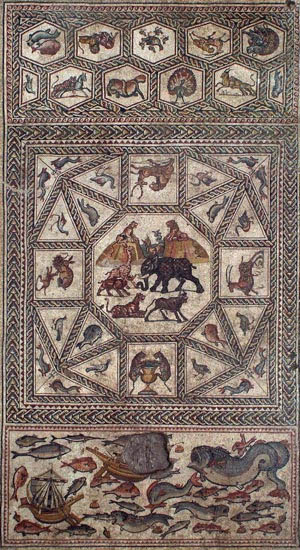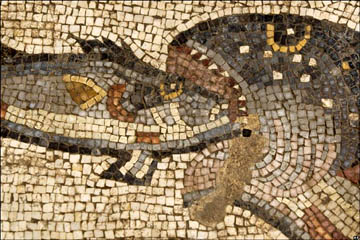Big Fish Eat Little Fish

|
| An overview of the recently re-uncovered mosaic in Lod. |
Some thirteen years ago Israeli archaeologist Miriam Avissar was asked to lead a rescue dig. Lod, ancient Lydda, where St Peter worked one of his miracles according to the book of Acts, wanted to widen a street and suspected that there might be ancient artefacts under where they wanted to dig. In their worst nightmares they could not have imagined what Miriam would find.
Only a few feet below the surface she discovered one of the largest and most perfect mosaics in the whole of Israel, a huge rectangle that covers 180 square metres, divided into three sections. All the sections basically face the same way, so if we imagine standing in a doorway looking at the mosaic so that the figures are the right way up, this is what we would see.
Immediately at our feet is an ocean scene with a couple of boats (one of which is badly damaged, about the only part of the mosaic to be damaged, are sailing across a space that is filled with a multitude of sea creatures. Right at the bottom of this space there is a large fish caught in the act of swalowing a small fish.
Furthest from us is another rectangle of mosaic divided into hexagonal roundels. The four nearest us have a peacock and what appear to be a horse and a mountain goat being attacked by big cats. The ones furthest from us are also upside down - indicating that there must have been a door opposite where we are standing - again depicting a variety of birds, animals and fish.
In between is a square of mosaic comprising a central octagonal panel showing elephants and other exotic creatures, including two lions confronting each other from piles of rock while a deer walks timidly between. Around this are sixteen smaller panels, four square showing desert creatures and the rest triangular, each containing a fish.

|
| A detail of the Lod mosaic, showing one fish swallowing another. |
All the panels are surrounded and separated by strips of geometrical designs in black and white.
Unfortunately the remains of walls and so on were extremely fragmentary and some lay outside the excavated area, so we have no idea what the building was which housed this mosaic. Based on the design I would say that it is not a dining room, as these usually had pictures that faced where each diner would be sitting. My guess is that it was a reception area in a building belonging to someone who had a great interest in the sea - perhaps a successful shipping agent or merchant - but who also enjoyed the conventional pleasures of the chase.
Not long after it was discovered, Lod Municipality, in consultation with the Israeli Antiquities Authority, decided to cover the mosaic up again to preserve it while they decided what to do with it. The decision process has taken thirteen years and only reached a conclusion thanks to the generosity of wealthy sponsors who are paying for the mosaic to be uncovered, removed from its present location, conserved and then put on permanent display in a purpose-built building.
Lod hopes that it will result in an increase in tourism. Personally, despite the magnificence of the mosaic, I'm afraid that I wouldn't travel to the soul-less modern town just to see it. Perhaps they need to link it with some of the traditional sites - the house St Peter visited (there must be a church marking the spot!) and the house of St George, Lod's other claim to fame. I know there is a church that marks that spot.
One genuine object and two fakes - sounds about right for a tourist attraction!
© Kendall K. Down 2009





